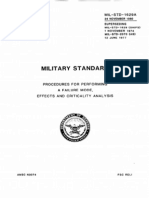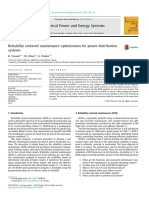Reliability Block Diagram and Calculation of A Complex System
Reliability Block Diagram and Calculation of A Complex System
Uploaded by
knurjanniCopyright:
Available Formats
Reliability Block Diagram and Calculation of A Complex System
Reliability Block Diagram and Calculation of A Complex System
Uploaded by
knurjanniOriginal Description:
Original Title
Copyright
Available Formats
Share this document
Did you find this document useful?
Is this content inappropriate?
Copyright:
Available Formats
Reliability Block Diagram and Calculation of A Complex System
Reliability Block Diagram and Calculation of A Complex System
Uploaded by
knurjanniCopyright:
Available Formats
Kartina Puji Nurjanni 306096
Master Course Industrial Engineering Gadjah Mada University Reliability Block Diagram and Calculation of a Complex System (DC Bus 1 Power Supply of Airbus A-320)
A. Introduction In this assignment, the electrical power supply of Airbus A-320 was chosen as the topic. Because the electrical power supply on the aircraft has a lot of sub-system, we consider the DC Bus 1 Power Supply of Airbus A-320 System as the main object to discuss. B. Reliability Block Diagram The reliability block diagram of DC Bus 1 Power Supply of Airbus A-320 System is depicted on figure 1. From figure 1, we can see that the system has twenty one blocks. out
in
Figure 1. Reliability block diagram of Bus 1 Power Supply of Airbus A-320 [Raksch et al., 2007] A = GEN 1 B = APU GEN C = GEN 2 D = GLC 1 E =AGLC F = GLC 2 G = BTC 1 H = BTC 2 I = BTC 1 J = BTC 2 K = AC BUS 1 L = AC BUS 2 M = TR 1 N = TR 2 O = 5 PU 1 P = 5 PU 2 Q = DC BUS 1 R = DCTC 1 S = DC BAT BUS T = DCTC 2 U = DC BUS 2
C. System Reliability Calculation Since the paths of reliability block diagram are obvious, the tie set method can be used for calculating the reliability value of the system. The calculation steps of DC Bus 1 Power Supply of Airbus A-320 System is shown below. 1. Simplify the block diagram We still can simplify the block diagram of Bus 1 Power Supply of Airbus A-320 on figure 1 into the block diagram that is shown on figure 2. out
in
Figure 2. Simplification of reliability block diagram Bus 1 Power Supply of Airbus A-320
If we replace the name of each block into numbering style, AD = 1 BE = 2 CF = 3 I = 4 H = 5 GJ = 6 KMO = 7 LNPUTSR = 8 Q = 9, the new block diagram will be depicted on figure 3.
1 4
in
out
2 5 3 8
Figure 3. Simplification of reliability block diagram Bus 1 Power Supply of Airbus A-320 on numbering style 2. Determine tie set a.) tie set 1
1 4
in
out
2 5 3 8
T1 = 179
b.) tie set 2
1 4
in
out
2 5 3 8
T2 = 1689
c.) tie set 3
1 4
in
out
2 5 3 8
T3 = 2479
d.) tie set 4
1 4
in
out
2 5 3 8
T4 = 2589
e.) tie set 5
1 4
in
out
2 5 3 8
out
T5 = 389
f.) tie set 6
1 4
in
2 5 3 8
T6 = 35479
g.) tie set 7
1 4
in
out
2 5 3 8
T7 = 25679
h.) tie set 8
1 4
in
out
2 5 3 8
T8 = 24689
i.) tie set 9
1 4
in
out
2 5 3 8
T9 = 165479
j.) tie set 10
1 4
in
out
2 5 3 8
T10 = 14589
k.) tie set 11
1 4
in
out
2 5 3 8
T11 = 354689
l.) tie set 12
1 4
in
out
2 5 3 8
T12 = 3679
Thus we have 12 tie sets, namely T1 T2 T3 T4 T5 T6 T7 T8 T9 T10 T11 T12 = = = = = = = = = = = = 1 1 2 2 3 3 2 2 1 1 3 3 7 6 4 5 8 5 5 4 6 4 5 6 9 8 7 8 9 4 6 6 5 5 4 7 9 9 9 7 7 8 4 8 6 9 9 9 9 7 9 8 = = = = = = = = = = = = AD AD BE BE CF CF BE BE AD AD CF CF KMO GJ I H LNPUTSR H H I GJ I H GJ Q LNPUTSR KMO LNPUTSR Q I GJ GJ H H I KMO Q Q Q KMO KMO LNPUTSR I LNPUTSR GJ Q Q Q Q KMO Q Q LNPUTSR Q
9 9
Figure 4. Minimal tie set of Bus 1 Power Supply of Airbus A-320 3. Reliability calculation In the tie set method, we use union probability concept for determine system reliability. Rs = P(T1 T2 T3 T4 T5 T6 T7 T8 T9 T10 T11 T12) where P(T1) = R1 R7 R9 P(T2) = R1 R6 R8 R9 P(T3) = R2 R4 R7 R9 P(T4) = R2 R5 R8 R9 P(T5) = R3 R8 R9 P(T6) = R3 R5 R4 R7 R9 P(T7) = R2 R5 R6 R7 R9 P(T8) = R2 R4 R6 R8 R9 P(T9) = R1 R6 R5 R4 R7 R9 P(T10) = R1 R4 R5 R8 R9 P(T11) = R3 R5 R4 R6 R8 R9 P(T12) = R3 R6 R7 R9
and
R1 R2 R3
= RA RD = R B RE = RC RF
R4 R5 R6
= RI = RH = R G RJ
R7 R8 R9
= RK RM R O = R L R N R P R U R T RS R R = RQ
thus Rs = P(T1 T2 T3 T4 T5 T6 T7 T8 T9 T10 T11 T12) Rs = P(T1) + + P(T12) - P(T1 T2) - - P(T11 T12) + P(T1 T2 T3) + + P(T10 T11 T12) - P(T1 T2 T3 T4) - P(T9 T10 T11 T12) + P(T1 T2 T3 T4 T5) + + P(T8 T9 T10 T11 T12) - P(T1 T2 T3 T4 T5 T6) - P(T7 T8 T9 T10 T11 T12) + P(T1 T2 T3 T4 T5 T6 T7) + + P(T6 T7 T8 T9 T10 T11 T12) P(T1 T2 T3 T4 T5 T6 T7 T8) - - P(T5 T6 T7 T8 T9 T10 T11 T12) + P(T1 T2 T3 T4 T5 T6 T7 T8 T9) + + P(T4 T5 T6 T7 T8 T9 T10 T11 T12) P(T1 T2 T3 T4 T5 T6 T7 T8 T9 T10) - - P(T3 T4 T5 T6 T7 T8 T9 T10 T11 T12) + P(T1 T2 T3 T4 T5 T6 T7 T8 T9 T10 T11) + + P(T2 T3 T4 T5 T6 T7 T8 T9 T10 T11 T12) - P(T1 T2 T3 T4 T5 T6 T7 T8 T9 T10 T11 T12)
Reference Raksch, C., van Maanen, R., Rehage, D., Thielecke, F, and Carl, U.B., 2007, Performance Degradation Analysis of Fault-Tolerant Aircraft Systems, [online accessed: 25 December 2011] URL: http://www.eurtd.com/moet/PDF/DGLR-CEAS%20congress%20%20TUHH%20Abstract.pdf
You might also like
- A Comparison and Case Studies of Electronic Product Reliability Prediction Methods Based On HandbooksNo ratings yetA Comparison and Case Studies of Electronic Product Reliability Prediction Methods Based On Handbooks4 pages
- FMEA & Reliability Block Diagram For Dishwasher System - 061011No ratings yetFMEA & Reliability Block Diagram For Dishwasher System - 06101111 pages
- Planning and Design Fundamentals of Airport100% (1)Planning and Design Fundamentals of Airport17 pages
- Reliability Growth and Repairable System Analysis Reference100% (1)Reliability Growth and Repairable System Analysis Reference392 pages
- FMEDA - Accurate Product Failure Metrics: John C. Grebe Dr. William M. Goble Exida Sellersville, PA 18960 USANo ratings yetFMEDA - Accurate Product Failure Metrics: John C. Grebe Dr. William M. Goble Exida Sellersville, PA 18960 USA8 pages
- Understanding The Reliability Block DiagramNo ratings yetUnderstanding The Reliability Block Diagram5 pages
- Reliability Best Practices: Review TheseNo ratings yetReliability Best Practices: Review These18 pages
- Introduction To Reliability and Maintenance100% (6)Introduction To Reliability and Maintenance48 pages
- Reliability Centered Maintenance Optimization For Power Distribution Systems 2014 International Journal of Electrical Power Energy SystemsNo ratings yetReliability Centered Maintenance Optimization For Power Distribution Systems 2014 International Journal of Electrical Power Energy Systems8 pages
- UTE FIDES Guide 2009 - Edition A - September 2010 English VersionNo ratings yetUTE FIDES Guide 2009 - Edition A - September 2010 English Version465 pages
- As IEC 61164-2008 Reliability Growth - Statistical Test and Estimation MethodsNo ratings yetAs IEC 61164-2008 Reliability Growth - Statistical Test and Estimation Methods8 pages
- SKF Reliability MaintenanceInstitute Courses PDFNo ratings yetSKF Reliability MaintenanceInstitute Courses PDF26 pages
- Autom Motiv e Hard Dware ISO e Deve O 262 Elopm 262 Ment A Accord Ing To oNo ratings yetAutom Motiv e Hard Dware ISO e Deve O 262 Elopm 262 Ment A Accord Ing To o5 pages
- STF38 Reliability Data For Control and Safety Systems 1998No ratings yetSTF38 Reliability Data For Control and Safety Systems 199847 pages
- Static Analysis of Software: The Abstract InterpretationFrom EverandStatic Analysis of Software: The Abstract InterpretationNo ratings yet
- Condition-based maintenance Complete Self-Assessment GuideFrom EverandCondition-based maintenance Complete Self-Assessment GuideNo ratings yet
- Structural and Crane Load Design Criteria For Building Systems100% (1)Structural and Crane Load Design Criteria For Building Systems13 pages
- Raytheon, US Navy Demonstrate New Electronic Attack Architecture Using MALD-J Aerial JammerNo ratings yetRaytheon, US Navy Demonstrate New Electronic Attack Architecture Using MALD-J Aerial Jammer2 pages
- Understanding The Difference Between Anti-Spoofing and Anti-JammingNo ratings yetUnderstanding The Difference Between Anti-Spoofing and Anti-Jamming4 pages
- Subject: Elac & Sec Reliability Ata Chapter: AIRCRAFT TYPE: A318, A319, A320, A321 Applicability: ReferencesNo ratings yetSubject: Elac & Sec Reliability Ata Chapter: AIRCRAFT TYPE: A318, A319, A320, A321 Applicability: References26 pages
- FTS Phase II (FLTechnics) - AIRBUS 2 Pages PDFNo ratings yetFTS Phase II (FLTechnics) - AIRBUS 2 Pages PDF152 pages
- PSA Airlines Pilot Interview Information and GougeNo ratings yetPSA Airlines Pilot Interview Information and Gouge65 pages
- A Practical Method For Determination of The Moments of Inertia of Unmanned Aerial VehiclesNo ratings yetA Practical Method For Determination of The Moments of Inertia of Unmanned Aerial Vehicles9 pages
- Jeppview For Windows: List of Pages in This Trip KitNo ratings yetJeppview For Windows: List of Pages in This Trip Kit39 pages
- Travel Reservation December 15 For MR HEIKO MAASNo ratings yetTravel Reservation December 15 For MR HEIKO MAAS2 pages
- ICAO-ICAEA RSSTA (1st Edition) Sample InformationNo ratings yetICAO-ICAEA RSSTA (1st Edition) Sample Information7 pages
- A Comparison and Case Studies of Electronic Product Reliability Prediction Methods Based On HandbooksA Comparison and Case Studies of Electronic Product Reliability Prediction Methods Based On Handbooks
- FMEA & Reliability Block Diagram For Dishwasher System - 061011FMEA & Reliability Block Diagram For Dishwasher System - 061011
- Reliability Growth and Repairable System Analysis ReferenceReliability Growth and Repairable System Analysis Reference
- FMEDA - Accurate Product Failure Metrics: John C. Grebe Dr. William M. Goble Exida Sellersville, PA 18960 USAFMEDA - Accurate Product Failure Metrics: John C. Grebe Dr. William M. Goble Exida Sellersville, PA 18960 USA
- Reliability Centered Maintenance Optimization For Power Distribution Systems 2014 International Journal of Electrical Power Energy SystemsReliability Centered Maintenance Optimization For Power Distribution Systems 2014 International Journal of Electrical Power Energy Systems
- UTE FIDES Guide 2009 - Edition A - September 2010 English VersionUTE FIDES Guide 2009 - Edition A - September 2010 English Version
- As IEC 61164-2008 Reliability Growth - Statistical Test and Estimation MethodsAs IEC 61164-2008 Reliability Growth - Statistical Test and Estimation Methods
- Autom Motiv e Hard Dware ISO e Deve O 262 Elopm 262 Ment A Accord Ing To oAutom Motiv e Hard Dware ISO e Deve O 262 Elopm 262 Ment A Accord Ing To o
- STF38 Reliability Data For Control and Safety Systems 1998STF38 Reliability Data For Control and Safety Systems 1998
- Static Analysis of Software: The Abstract InterpretationFrom EverandStatic Analysis of Software: The Abstract Interpretation
- Condition-based maintenance Complete Self-Assessment GuideFrom EverandCondition-based maintenance Complete Self-Assessment Guide
- Structural and Crane Load Design Criteria For Building SystemsStructural and Crane Load Design Criteria For Building Systems
- Raytheon, US Navy Demonstrate New Electronic Attack Architecture Using MALD-J Aerial JammerRaytheon, US Navy Demonstrate New Electronic Attack Architecture Using MALD-J Aerial Jammer
- Understanding The Difference Between Anti-Spoofing and Anti-JammingUnderstanding The Difference Between Anti-Spoofing and Anti-Jamming
- Subject: Elac & Sec Reliability Ata Chapter: AIRCRAFT TYPE: A318, A319, A320, A321 Applicability: ReferencesSubject: Elac & Sec Reliability Ata Chapter: AIRCRAFT TYPE: A318, A319, A320, A321 Applicability: References
- PSA Airlines Pilot Interview Information and GougePSA Airlines Pilot Interview Information and Gouge
- A Practical Method For Determination of The Moments of Inertia of Unmanned Aerial VehiclesA Practical Method For Determination of The Moments of Inertia of Unmanned Aerial Vehicles
- Jeppview For Windows: List of Pages in This Trip KitJeppview For Windows: List of Pages in This Trip Kit

























































































